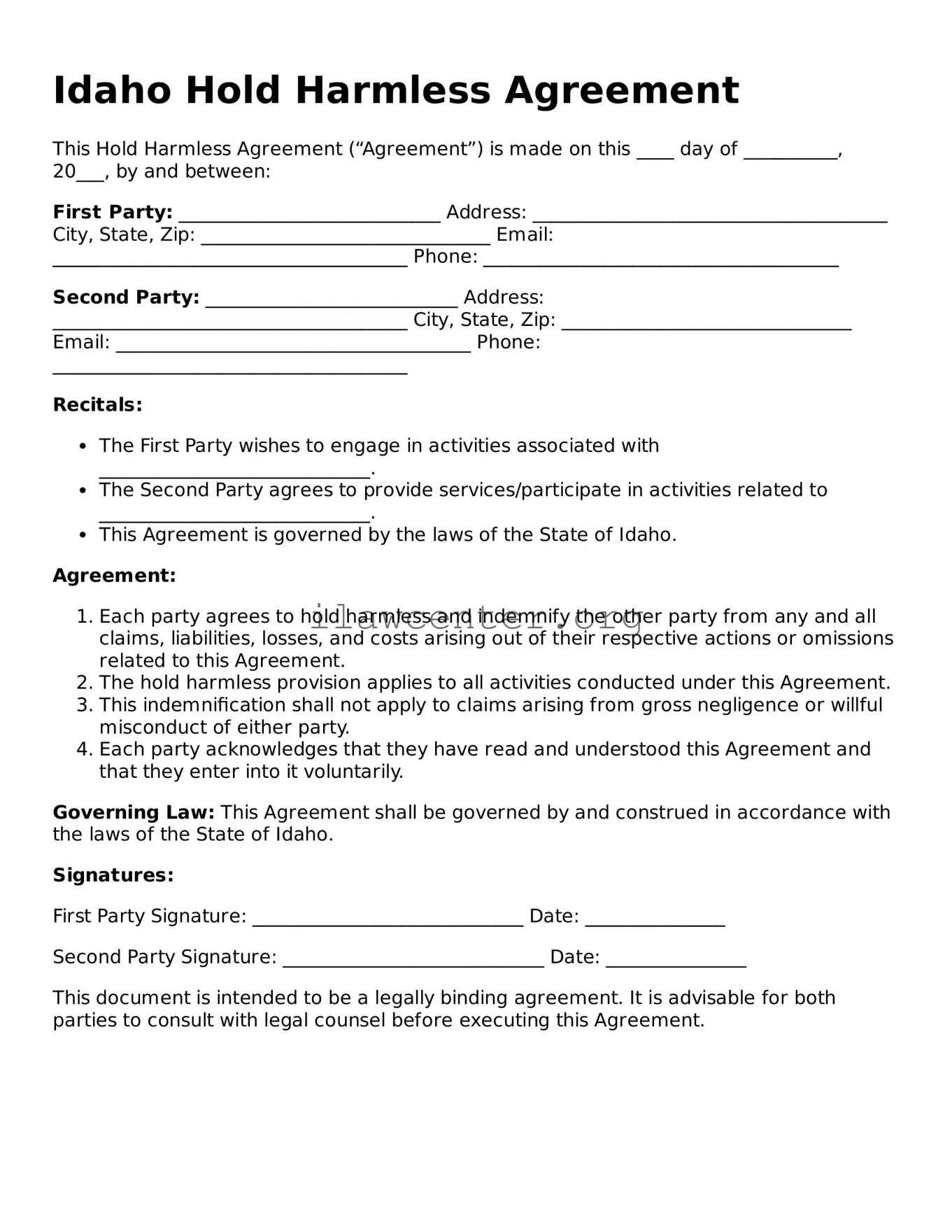What is an Idaho Hold Harmless Agreement?
An Idaho Hold Harmless Agreement is a legal document designed to protect one party from liability for damages or injuries that may occur during a specified activity or event. This agreement typically involves two parties: the indemnitor, who agrees to assume the risk and liability, and the indemnitee, who is protected from potential claims. It can be used in a variety of situations, such as events, recreational activities, or contract agreements, and ensures that the indemnitor will not hold the indemnitee responsible for certain acts or omissions.
What is the purpose of using a Hold Harmless Agreement?
The primary purpose of a Hold Harmless Agreement is to minimize legal risk. By signing this document, parties agree that if an injury or damage occurs during the specified activity, the indemnitor will not seek compensation from the indemnitee. This arrangement is particularly helpful in activities where accidents could happen, such as sports events or community gatherings, providing assurance that the indemnitee is not liable for unexpected incidents.
Who should use a Hold Harmless Agreement?
A Hold Harmless Agreement is often used by event organizers, property owners, educators, and businesses. Anyone who wants to involve others in activities that carry potential risks could benefit from this agreement. For instance, a landlord might require tenants to sign this document to protect against claims related to accidents on the property. It can also be useful for coaches, instructors, and volunteers who operate in environments where injuries may occur.
Are there specific elements that must be included in the agreement?
Yes, a Hold Harmless Agreement should include specific elements for it to be valid. These elements typically encompass the names and contact information of the parties involved, a clear description of the event or activity, liability disclaimers outlining the extent of the hold harmless provision, and signatures of both parties. Additionally, it's wise to include a clause addressing what happens in the event of a legal dispute, as well as the jurisdiction in which the agreement will be enforced.
Is a Hold Harmless Agreement enforceable in Idaho?
Generally, Hold Harmless Agreements can be enforceable under Idaho law, provided they are clearly written, voluntary, and do not violate any public policy. Certain limitations may apply, such as instances involving gross negligence or intentional misconduct. Courts may scrutinize agreements more closely in these situations, so it’s essential to ensure that the language used is clear and unambiguous, reflecting the intent of both parties.
Can a Hold Harmless Agreement be revoked?
Once signed, a Hold Harmless Agreement is typically binding, meaning it cannot be easily revoked. However, both parties can mutually agree to modify or terminate the agreement at any time, provided such changes are documented in writing. Additionally, if one party breaches the terms of the agreement or if circumstances change significantly, it may become unenforceable. Consulting with legal counsel can clarify the options available to revoke or amend the agreement.
How can individuals obtain a Hold Harmless Agreement form in Idaho?
Individuals looking to obtain a Hold Harmless Agreement form can often find templates online or through legal service providers. Many law firms and legal websites offer customizable forms that can be tailored to specific needs. Additionally, consulting with an attorney can provide guidance on drafting an adequate agreement that meets Idaho's legal standards and addresses specific circumstances effectively.
